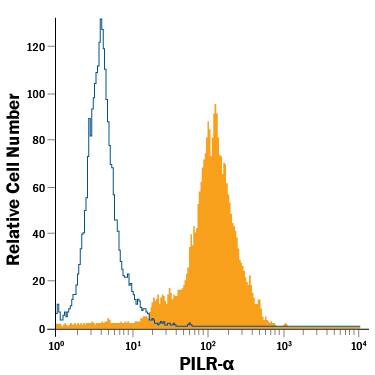Mouse PILR-alpha Alexa Fluor® 488-conjugated Antibody
R&D Systems, part of Bio-Techne | Catalog # FAB4318G


Key Product Details
Species Reactivity
Applications
Label
Antibody Source
Product Specifications
Immunogen
Leu21-Val197
Accession # Q2YFS3
Specificity
Clonality
Host
Isotype
Scientific Data Images for Mouse PILR-alpha Alexa Fluor® 488-conjugated Antibody
Detection of PILR‑ alpha in J774A.1 Mouse Cell Line by Flow Cytometry.
J774A.1 mouse reticulum cell sarcoma macrophage cell line was stained with Goat Anti-Mouse PILR-a Alexa Fluor® 488-conjugated Antigen Affinity-purified Polyclonal Antibody (Catalog # FAB4318G, filled histogram) or isotype control antibody (Catalog # IC108G, open histogram). View our protocol for Staining Membrane-associated Proteins.Applications for Mouse PILR-alpha Alexa Fluor® 488-conjugated Antibody
Flow Cytometry
Sample: J774A.1 mouse reticulum cell sarcoma macrophage cell line
Formulation, Preparation, and Storage
Purification
Formulation
Shipping
Stability & Storage
Background: PILR-alpha
PILR-alpha (Paired Immunoglobulin-like type 2 Receptor-alpha), also named FDF03, is one of two members of a small family of immunoregulatory Ig-superfamily receptors (1, 2). It is a counterpart to PILR-beta and it likely gave rise to PILR-beta through gene duplication and rearrangement (1). The PILRs represent one of many pairs of Ig-like domain-containing receptors that participate in immune regulation. PILR-alpha and -beta should not be confused with the similarly named PIRs (also paired immunoglobulin‑like receptors), or the functionally-related SIRP and ILT/LILR/CD85/LIR family of receptors (2). While PIRs, ILTs and SIRPs contain three to six Ig‑like domains in their extracellular region, PILR-alpha and -beta show only one Ig-like region in their extracellular domain (ECD) (1, 2). Mouse PILR-alpha is a monomeric, 271 amino acid (aa) type I transmembrane (TM) protein (3). It contains a 167 aa ECD, a 21 aa TM segment, and a long, 83 aa cytoplasmic region. The ECD shows one V‑type Ig-like domain between aa 40-134, while the cytoplasmic region contains two ITIMs (immunoreceptor Tyr-based inhibitory motifs) between aa 265-270 and 294‑299. Given that ITIMs are known to interact with phosphatases such as PTPN6 and PTPN11, the presence of these motifs makes mouse PILR-alpha an inhibitory receptor. In human, activation of PILR-alpha inhibits CD32/Fc gammaRII-induced calcium mobilization (3). Although CD99 is a known ligand for both PILR-alpha and -beta (4), highest affinity binding seems to occur between CD99 and PILR-alpha (4). Mouse PILR-alpha is found on neutrophils and macrophages (4). The additional ligands for PILR-alpha have been reported. One is PANP that is expressed in neural tissue, while two others are NPDC1 and Collectin-12. In all cases, O-linked carbohydrates on the ligands are central to binding (5,6). Mouse PILR-alpha ECD is 43% and 69% aa identical to human and rat PILR-alpha ECD, respectively; it is 75% aa identical to the ECD of mouse PILR-beta (3).
References
- Wilson, M.D. et al. (2006) Physiol. Genomics 27:201.
- Lanier, L.L. (2001) Curr. Opin. Immunol. 13:326.
- Fournier, N. et al. (2000) J. Immunol. 165:1197.
- Shiratori, I. et al. (2004) J. Exp. Med. 199:525.
- Kogure, A. et al. (2011) Biochem. Biophys. Res. Commun. 405:428.
- Sun, Y. et al. (2012) J. Biol. Chem. 287:15837.
Long Name
Alternate Names
Gene Symbol
UniProt
Additional PILR-alpha Products
Product Specific Notices for Mouse PILR-alpha Alexa Fluor® 488-conjugated Antibody
This product is provided under an agreement between Life Technologies Corporation and R&D Systems, Inc, and the manufacture, use, sale or import of this product is subject to one or more US patents and corresponding non-US equivalents, owned by Life Technologies Corporation and its affiliates. The purchase of this product conveys to the buyer the non-transferable right to use the purchased amount of the product and components of the product only in research conducted by the buyer (whether the buyer is an academic or for-profit entity). The sale of this product is expressly conditioned on the buyer not using the product or its components (1) in manufacturing; (2) to provide a service, information, or data to an unaffiliated third party for payment; (3) for therapeutic, diagnostic or prophylactic purposes; (4) to resell, sell, or otherwise transfer this product or its components to any third party, or for any other commercial purpose. Life Technologies Corporation will not assert a claim against the buyer of the infringement of the above patents based on the manufacture, use or sale of a commercial product developed in research by the buyer in which this product or its components was employed, provided that neither this product nor any of its components was used in the manufacture of such product. For information on purchasing a license to this product for purposes other than research, contact Life Technologies Corporation, Cell Analysis Business Unit, Business Development, 29851 Willow Creek Road, Eugene, OR 97402, Tel: (541) 465-8300. Fax: (541) 335-0354.
For research use only